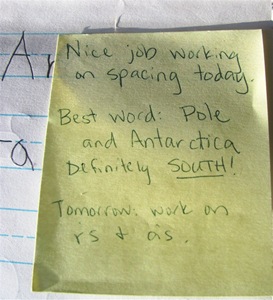Does your child complain of a sore or tired hand while writing?
I received a nice letter from Erica yesterday. A while back, she'd studied our Writing/Handwriting pages and bought some of the recommended pencils and grips for her son who is in 2nd Grade. Back then, she was concerned, because the boy was saying he hated school. After some discussion, he mentioned that his hand hurt from writing so much. Helping him change his grasp and giving him a different pencil made a huge difference and his attitude towards school dramatically improved.
Rachel, in the photo, is three years-old and developed the tripod grasp naturally on her own. See how she holds her crayon? Beautiful! Not all three year-olds can hold their pencil this way.
At three, a child's fine and gross motor skills are still developing and many children don't have the control for holding a crayon or pencil in the tripod grasp. Let them draw and don't fret about their grasp—their fine and gross motor skills will develop. Generally, I like to start working with the child on the tripod grasp when they are five or around the time they want to start writing their name.
Erica's seven year-old son is a bright boy and probably had a pencil in hand at a young age, but unlike Rachel, he didn't transition into the tripod grasp. At three years-old, the way he held a pencil served him well, but proved to be a hindrance at the age of seven.
What helped Erica's son was changing to a soft-lead pencil with a gripper and a little instruction and encouragement from Mom.










